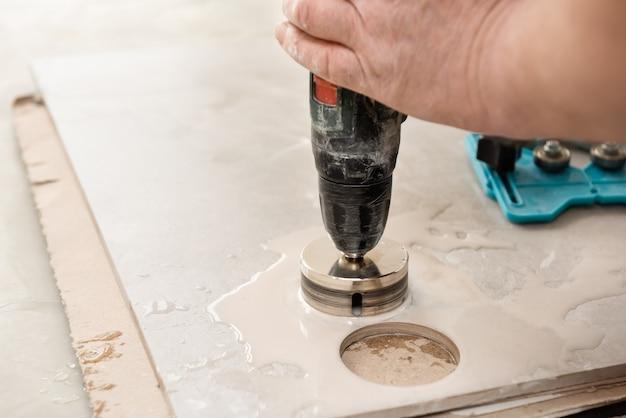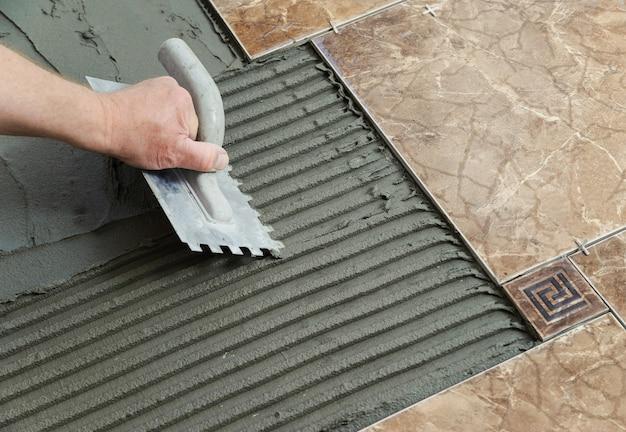Ceramic tiles are a popular choice for their durability, versatility, and aesthetic appeal. But when it comes to working with ceramic tiles, questions often arise about which tools can be used without damaging the delicate surface. One common query is whether a masonry bit can be used on ceramic tile. In this blog post, we will explore this topic and provide insights to help you understand the best approach for drilling into ceramic tiles.
From understanding the differences between porcelain and ceramic tiles to choosing the right drill bit for the job, we will cover it all. We will also address other related queries, such as hanging mirrors or shelves on ceramic tiles, drilling into grout versus tile, and the advantages and disadvantages of using ceramic tiles. So, if you’re looking to embark on a DIY tile project or simply want to expand your knowledge, keep reading to find answers to all your questions.
Can I Use A Masonry Bit On Ceramic Tile
If you’re a DIY enthusiast or just a homeowner looking to spruce up your space, the thought of drilling into ceramic tile might be enough to make you break out in a cold sweat. Ceramic tile is known for its delicate nature and propensity to crack under pressure. But fear not, brave home improvers! We’re here to answer that burning question: can you use a masonry bit on ceramic tile?
The Delicate Dance of Drilling
Drilling into ceramic tile requires finesse and a gentle touch. It’s like trying to dance the tango with a delicate flower – a misstep could lead to disaster. While a masonry bit is designed for tougher materials like concrete and stone, it can indeed be used on ceramic tile. However, there are a few important things to keep in mind before you break out your power tools and boogie on down to your next home improvement project.
Slow and Steady Wins the Race
When drilling into ceramic tile, speed is not your friend. It’s no time for a race against the clock. Slow and steady is the name of the game. Using a low speed setting on your drill and applying gentle, consistent pressure will help prevent the tile from cracking or chipping. It’s a delicate dance, my friends, so take your time and let the drill do the work.
The Right Bit for the Job
While a masonry bit can be used on ceramic tile, it’s not the only option out there. If you want to give your tile the VIP treatment, consider using a tile-specific drill bit. These specialized bits are designed with a carbide tip that’s perfect for cutting through ceramic tile without causing any damage. It’s like having a dance partner who knows all the right moves.
Play It Safe
Before you start drilling, it’s important to take some precautions to protect yourself and your tile. Safety goggles are a must to shield your eyes from any flying debris. And don’t forget to lay a piece of masking tape on the tile surface to prevent the drill bit from slipping and scratching the tile. It’s better to be safe than sorry – no one likes a scratched dance floor!
Take a Test Drive
If you’re feeling a bit unsure about your drilling skills or the integrity of your tile, it’s always a good idea to do a test run on a scrap piece of tile. This will give you the opportunity to practice your moves and ensure that you’re doing it right before you take center stage on your actual tile. Remember, practice makes perfect – even on the dance floor.
Don’t Push Your Luck
Despite your best efforts, accidents can happen. If you encounter resistance or the tile starts to crack, stop immediately. It’s better to regroup and reassess than to push your luck and end up with a broken tile. Sometimes you just have to accept that not every dance partner is meant to tango.
So there you have it, friends – the answer to the age-old question: can you use a masonry bit on ceramic tile? The answer is yes, but with caution, patience, and a gentle touch. Approach it like a delicate dance, and you’ll be drilling into tile like a pro in no time. Now go forth and boogie on, you DIY dance warriors of the ceramic tile!
FAQ: Can I Use A Masonry Bit On Ceramic Tile
Which is more expensive: porcelain or ceramic tile
When it comes to cost, porcelain tile tends to be more expensive than ceramic tile. Porcelain is known for its higher durability and resistance to moisture, making it a popular choice for areas that experience a lot of foot traffic or water exposure.
Should I grout walls or floor first
It’s generally recommended to grout the walls first before moving on to the floor. By grouting the walls first, you can avoid accidentally dropping any grout particles onto the freshly laid floor tiles and potentially damaging them. Plus, it’s usually easier to reach the walls without having to step on the floor.
Can you use a hammer drill on porcelain tile
Yes, you can use a hammer drill on porcelain tile. However, it’s important to use a carbide-tipped masonry bit specifically designed for drilling into hard materials like porcelain. Take your time and use gentle pressure to avoid cracking or damaging the tile. And remember, patience is key!
How do you hang a mirror on ceramic tile
Hanging a mirror on ceramic tile requires a few essential steps. First, determine the best location for your mirror. Then, use a diamond-tipped glass and tile bit to carefully drill holes into the tile where you want to hang the mirror. Insert wall anchors into the holes, and finally, attach the mirror using screws or mirror mounting clips. Voila! Your mirror is now securely hung on ceramic tile.
How long does it take to drill through ceramic tile
The time it takes to drill through ceramic tile can vary depending on various factors, including the type of tile, the thickness of the tile, and the drilling technique. On average, drilling through ceramic tile can take anywhere from a few minutes to around 15 minutes per hole. Remember, it’s important to take it slow and steady to avoid damaging the tile.
What anchors to use in ceramic tile
To properly anchor items on ceramic tile, it’s best to use specialized wall anchors designed for use in tile. Plastic expansion anchors or toggle bolts are commonly used options. Just make sure to choose anchors that are compatible with the weight and size of the item you’re anchoring.
Can you screw into ceramic tile
While it is possible to screw directly into ceramic tile, it’s generally not recommended. Ceramic tile is prone to cracking and can be easily damaged by the twisting force exerted by the screw. To avoid potential tile damage, it’s best to use wall anchors or other specialized hardware specifically designed for tile installations.
Are subway tiles porcelain or ceramic
Subway tiles can be made from either porcelain or ceramic. Both materials offer a variety of benefits and come in various styles and colors. Whether you choose porcelain or ceramic subway tiles depends on your personal preference, as well as the specific characteristics and needs of your project.
What does a masonry bit look like
A masonry bit typically has a distinctive carbide or diamond-tipped point. It often resembles a twisted drill bit with a fluted design to help remove debris while drilling into hard materials like ceramic tile. These bits are specifically designed to withstand the high heat and friction generated during masonry drilling.
Can I use a concrete drill bit on ceramic tile
Using a concrete drill bit on ceramic tile is not recommended. Concrete drill bits are designed for drilling into much harder materials than ceramic tile and may result in cracking or damaging the tile. It’s best to use a specialized carbide-tipped masonry bit designed for ceramic tile to ensure clean and safe drilling.
What kind of drill do you use for ceramic tile
For drilling into ceramic tile, it’s best to use a variable speed drill with a hammer function or a cordless drill with adjustable torque settings. Pair your drill with a carbide-tipped masonry bit specifically designed for ceramic tile to achieve the best drilling results. Remember to keep the drill at a low speed and apply gentle pressure to prevent tile damage.
Can you hang shelves on tile
Yes, you can hang shelves on tile, but proper installation is crucial to ensure stability. It’s recommended to use specialized wall anchors designed for tile installations and to follow the manufacturer’s instructions for weight capacity. By using anchors specifically designed for tile, you can securely hang shelves without worrying about damaging the tile or compromising the integrity of your installation.
What are the disadvantages of ceramic tiles
While ceramic tiles have many advantages, it’s important to consider their potential disadvantages as well. Ceramic tiles can be more prone to cracking or chipping compared to other materials like porcelain. They are also less water-resistant and more susceptible to staining if not properly sealed. Additionally, ceramic tiles can be colder and harder underfoot, making them less comfortable for extended periods of standing.
Should I drill into tile or grout
When drilling into ceramic tile, it’s generally best to drill into the tile itself rather than the grout. Tile is a more stable and durable material compared to grout, which is softer and more prone to cracking. By drilling into the tile, you can ensure a secure and stable anchor point for any installations without compromising the structural integrity of the grout lines.
How can I tell if my tile is ceramic or porcelain
To determine whether your tile is ceramic or porcelain, you can perform a simple water absorption test. Place a few drops of water on the tile’s surface and observe how quickly it is absorbed. If the water is absorbed quickly, the tile is likely ceramic. If the water beads or takes a while to absorb, it is likely porcelain. Remember to wipe away the water after the test to avoid any potential water damage.
What is better: porcelain or ceramic tile
The choice between porcelain and ceramic tile depends on your specific needs and preferences. Porcelain tile is generally more durable, water-resistant, and suitable for high-traffic areas. On the other hand, ceramic tile offers a wider range of design options and tends to be more budget-friendly. Consider the intended location, usage, and your desired aesthetic to determine which type of tile is better suited for your project.
What drill bit should I use for porcelain tile
When drilling through porcelain tile, it’s crucial to use a diamond-tipped drill bit specifically designed for hard materials like porcelain. Diamond drill bits offer the durability and precision necessary to effectively drill through the dense surface of porcelain without causing cracks or damage.
Does grout strengthen tile
While grout serves important purposes such as filling the gaps between tiles and preventing moisture penetration, it doesn’t necessarily strengthen the tiles themselves. The strength of a tiled surface primarily relies on the adhesive or mortar used during installation, along with the overall structure and support behind the tiles.
Do you need a hammer drill for tile
While a hammer drill can be useful for drilling into harder materials like concrete or stone, it is not essential for drilling into tile. When using the correct drill bit and proper drilling technique, a regular variable speed drill is typically sufficient for drilling into ceramic or porcelain tile. Just remember to take it slow, apply gentle pressure, and let the drill do the work.
Happy drilling, tile enthusiasts! Remember to exercise caution, take your time, and equip yourself with the right tools and techniques. With a little patience and a touch of DIY know-how, you’ll be transforming your space with beautiful ceramic tile in no time!

